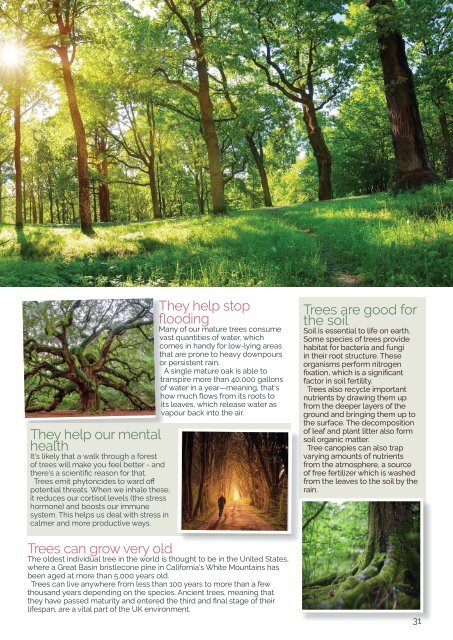Rhiwbina Living
Summer 2023 issue of Rhiwbina Living, the award-winning magazine for Rhiwbina.
Summer 2023 issue of Rhiwbina Living, the award-winning magazine for Rhiwbina.
- TAGS
- wales
- whitchurch
- rhiwbina
- cardiff
Create successful ePaper yourself
Turn your PDF publications into a flip-book with our unique Google optimized e-Paper software.
They help our mental<br />
health<br />
It's likely that a walk through a forest<br />
of trees will make you feel better - and<br />
there's a scientific reason for that.<br />
Trees emit phytoncides to ward off<br />
potential threats. When we inhale these,<br />
it reduces our cortisol levels (the stress<br />
hormone) and boosts our immune<br />
system. This helps us deal with stress in<br />
calmer and more productive ways.<br />
They help stop<br />
flooding<br />
Many of our mature trees consume<br />
vast quantities of water, which<br />
comes in handy for low-lying areas<br />
that are prone to heavy downpours<br />
or persistent rain.<br />
A single mature oak is able to<br />
transpire more than 40,000 gallons<br />
of water in a year—meaning, that's<br />
how much flows from its roots to<br />
its leaves, which release water as<br />
vapour back into the air.<br />
Trees can grow very old<br />
The oldest individual tree in the world is thought to be in the United States,<br />
where a Great Basin bristlecone pine in California's White Mountains has<br />
been aged at more than 5,000 years old.<br />
Trees can live anywhere from less than 100 years to more than a few<br />
thousand years depending on the species. Ancient trees, meaning that<br />
they have passed maturity and entered the third and final stage of their<br />
lifespan, are a vital part of the UK environment.<br />
Trees are good for<br />
the soil<br />
Soil is essential to life on earth.<br />
Some species of trees provide<br />
habitat for bacteria and fungi<br />
in their root structure. These<br />
organisms perform nitrogen<br />
fixation, which is a significant<br />
factor in soil fertility.<br />
Trees also recycle important<br />
nutrients by drawing them up<br />
from the deeper layers of the<br />
ground and bringing them up to<br />
the surface. The decomposition<br />
of leaf and plant litter also form<br />
soil organic matter.<br />
Tree canopies can also trap<br />
varying amounts of nutrients<br />
from the atmosphere, a source<br />
of free fertilizer which is washed<br />
from the leaves to the soil by the<br />
rain.<br />
31

















